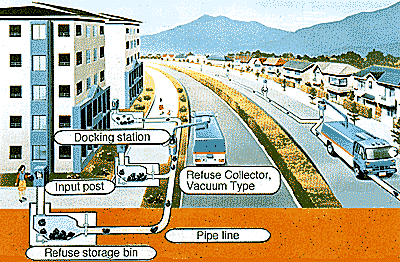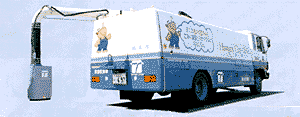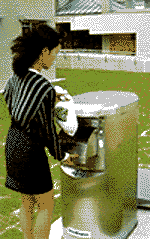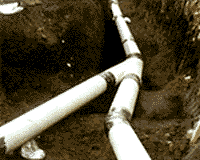Waste Treatment Technology in JAPAN
Collection, Transportation and Storage
2. Reduced collecting costs A vacuum refuse collector operated by a single person
automatically collects the refuse by way of an loading station thus minimizing
the collecting costs.
3. Satisfactory customer service Residents are allowed to put refuse into
disposal chutes or posts at any time. It is not necessary to keep a refuse
container or to remember the date of disposal of household refuse anymore.
4. Good urban landscapes Refuse-free streets provide a sanitary and good looking
landscape and foul odors emitted from the rotting refuse in the past are
entirely eliminated.
5. Low maintenance costs Simple design and components employed remarkably
reduces maintenance costs.
6. Adaptability This system is flexibly adaptable for use at a single building
as well as at huge apartment complexes and extensible depending on the needs
and budgets.
"TECHNOCUUM" Refuse Collecting and Transporting System
Microcomputer-controlled vacuum type refuse collecting vehicle
b) All refuse that have been disposed of via disposal chutes and posts are temporarily
stored in storage tanks.
c) To load the refuse from a storage tank into the refuse collector, a suction hose
is to be connected to the loading station which is provided at a proper location
and intervals so as to fully cover all storage tanks belonging to the system.
d) IN or OUT gate of the storage tank opens or closes as a control signal is so sent
from the refuse collector.
e) To suck refuse from the selected storage tank, a negative pressure of approximately
minus 3,500 mmAq is to be applied from the collector so that an air intake valve
of the tank is open and refuse in the tank is swirled away into the collector.
f) When the refuse contained in one of the tanks has been fully evacuated, the OUT
gate of the tank is to be closed to proceed to the next tank to repeat the same
procedure.
g) The refuse collection from each of the tanks belonging to a loading station is
automatically controlled by the refuse collector connected to the station. In
this event, electrical power supply from the building side is not required.
h) After completing all of the refuse collecting works, the suction hose is to be
disconnected from the station and the refuse collector is ready for onward
transportation.
Refuse storage bin
Pipe line
(OUTLINE)
This highly advanced system uses a vacuum type underground pipe network to load household refuse from underground refuse storage tanks by way of a loading station into a dedicated refuse collecting vehicle, called refuse collector.
(FEATURES)
1. Improved working condition Since the collecting work is carried out free
from direct contact with the refuse that threatens contagions, ensuring a
better working condition.
Refuse is disposed of via an indoor disposal chute provided on each floor of a building or outdoor disposal posts in front of the building and then temporarily stored in underground storage tanks. The stored refuse is loaded, by utilizing vacuum suction force, into a refuse collecting vehicle through an underground pipe network and a loading station.


(OPERATION PROCESS)
a) Household refuse is directly disposed of either by putting it in an indoor refuse
disposal chute or outdoor refuse disposal post.
Input post


